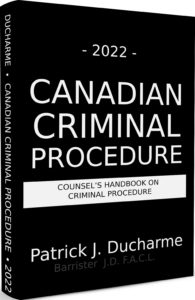 |
| Patrick Ducharme |
Continued from Part 1: The Cases of Grant and Harrison
In Grant the Supreme Court of Canada dealt with a different type of infringement of the right to be free from unreasonable search or seizure. This case involved an appeal by Grant from his convictions on a series of firearms offences, relating to a gun seized by police during an encounter on a Toronto sidewalk. After noting that Grant, who was walking down the street, was fidgeting with his pants, a police officer initiated an exchange with him, while standing on the sidewalk directly in his intended path. At one point, Grant adjusted his jacket, which prompted the officer to ask him to keep his hands in front of him.
Two other officers approached the pair on the sidewalk and took up positions behind the first officer, obstructing the way forward. The third officer then asked Grant whether he had anything he should not have, to which Grant answered that he had marijuana and a firearm.
Grant was convicted of five firearms offences. The Court of Appeal concluded that a detention had crystallized during the conversation with the officer, before Grant made his incriminating statements, and that the detention was arbitrary and in breach of section 9 of the Charter. However, the appellate court held that the gun should be admitted into evidence under subsection 24(2) of the Charter. The court agreed with the trial Judge that Grant’s act of moving the gun from one place to another fell within the definition of “transfer” in the Criminal Code, and that this justified the conviction for possession of a firearm for the purposes of weapons trafficking.
The Supreme Court of Canada disagreed to this extent: the court allowed his appeal on the trafficking charge. The court held that detention under sections 9 and 10 of the Charter refers to a suspension of the individual’s liberty interest by a significant physical or psychological restraint. Psychological detention is established either where the individual has a legal obligation to comply with a restrictive request or demand, or a reasonable person would conclude by reason of the state conduct that he or she had no choice but to comply. It is for the trial Judge, applying the proper legal principles to the particular facts of the case, to determine whether the line has been crossed between police conduct that respects liberty and the individual’s right to choose, and conduct that does not.
In Grant, the sustained and restrictive tenor of the conduct after the direction to Grant to keep his hands in front of him reasonably supported the conclusion the that he was detained within the meaning of sections 9 and 10 of the Charter before being asked the questions that led him to disclose his possession of the firearm. The evidence of the firearm was obtained in a manner that infringed Grant’s rights under sections 9 and 10(b) of the Charter. The officers acknowledged at trial that they did not have legal grounds or reasonable suspicion to detain the accused prior to his incriminating statements. Thus, the detention was arbitrary. Section 10(b) of the Charter required the police to advise Grant that he had the right to speak to a lawyer, and to give him a reasonable opportunity to obtain legal advice if he so chose, before proceeding to elicit incriminating information from him.
With respect to the application for exclusion under subsection 24(2), the court assessed the effect of admitting the evidence balanced against society’s confidence in the Justice system having regard to: (1) the seriousness of the Charter-infringing state conduct, (2) the impact of the breach on the Charter-protected interests of the accused, and (3) society’s interest in the adjudication of the case on its merits. When the three-stage inquiry was applied to the facts of this case, a balancing of the factors favoured the admission of the firearm into evidence. The Charter infringing conduct was not deliberate or egregious. Further, the impact of the breach on Grant’s interests was significant, but not at the most serious end of the scale. Finally, the gun was highly reliable evidence and essential to a determination on the merits.
In the end the Supreme Court of Canada found that the courts below did not err in concluding that the admission of the gun into evidence would not, on balance, bring the administration of justice into disrepute. Grant’s conviction for possession of a firearm for the purposes of weapons trafficking was quashed on the ground that he did not “transfer” the firearm, as Parliament did not intend subsection 100(1) of the Code to address the simple movement of a firearm from one place to another.

The above is the an excerpt of Patrick J Ducharme’s book, Canadian Criminal Procedure, available at Amazon or in bulk through MedicaLegal Publishing along with Criminal Trial Strategies.
Subscribe to Patrick Ducharme’s Youtube Channel
